

Compact Muon Solenoid
LHC, CERN
| CMS-TOP-23-005 ; CERN-EP-2024-258 | ||
| Measurement of the inclusive $ \mathrm{t} \overline{\mathrm{t}} $ cross section in final states with at least one lepton and additional jets with 302 pb$^{-1}$ of pp collisions at $ \sqrt{s}= $ 5.02 TeV | ||
| CMS Collaboration | ||
| 28 October 2024 | ||
| JHEP 04 (2025) 099 | ||
| Abstract: A measurement of the top quark pair ($ \mathrm{t} \overline{\mathrm{t}} $) production cross section in proton-proton collisions at a centre-of-mass energy of 5.02 TeV is presented. The data were collected at the LHC in autumn 2017, in dedicated runs with low-energy and low-intensity conditions with respect to the default configuration, and correspond to an integrated luminosity of 302 pb$^{-1}$. The measurement is performed using events with one electron or muon, and multiple jets, at least one of them being identified as b quark (b tagged). Events are classified based on the number of all reconstructed jets and of b-tagged jets. Multivariate analysis techniques are used to enhance the separation between the signal and backgrounds. The measured cross section is 62.5 $ \pm $ 1.6 (stat) $ {} ^{+2.6}_{-2.5} $ (syst) $ \pm $ 1.2 (lumi) pb. A combination with the result in the dilepton channel based on the same data set yields a value of 62.3 $ \pm $ 1.5 (stat) $ \pm $ 2.4 (syst) $ \pm $ 1.2 (lumi) pb, to be compared with the standard model prediction of 69.5 $ {}^{+3.5}_{-3.7} $ pb at next-to-next-to-leading order in perturbative quantum chromodynamics. | ||
| Links: e-print arXiv:2410.21631 [hep-ex] (PDF) ; CDS record ; inSPIRE record ; HepData record ; CADI line (restricted) ; | ||
| Figures | |
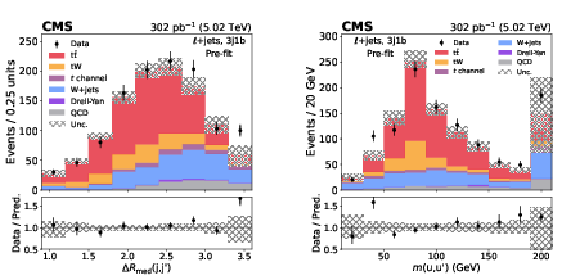
png pdf |
Figure 1:
Distributions for data and expected signal and background contributions of the most discriminating input variables used for the random forest training, $ \Delta R_\mathrm{med}(\mathrm{j},\mathrm{j}') $ (left) and $ m(\mathrm{u}\mathrm{u}') $(right), in the 3j1b category, before the maximum likelihood fit. The vertical error bars represent the statistical uncertainty in the data, and the shaded band the uncertainty in the prediction. All uncertainties considered in the analysis are included in the uncertainty band. The lower panels show the data-to-prediction ratio. The first and last bins in each distribution include underflow and overflow events, respectively. The normalizations are taken with respect to the SM predictions except for QCD, which is estimated from data. |
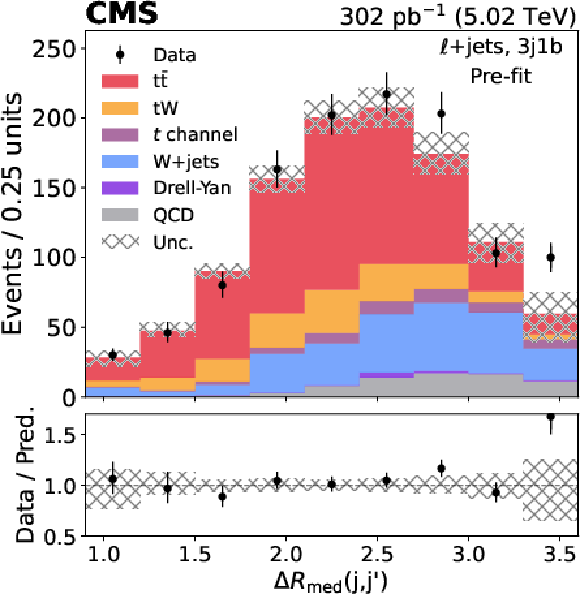
png pdf |
Figure 1-a:
Distributions for data and expected signal and background contributions of the most discriminating input variables used for the random forest training, $ \Delta R_\mathrm{med}(\mathrm{j},\mathrm{j}') $ (left) and $ m(\mathrm{u}\mathrm{u}') $(right), in the 3j1b category, before the maximum likelihood fit. The vertical error bars represent the statistical uncertainty in the data, and the shaded band the uncertainty in the prediction. All uncertainties considered in the analysis are included in the uncertainty band. The lower panels show the data-to-prediction ratio. The first and last bins in each distribution include underflow and overflow events, respectively. The normalizations are taken with respect to the SM predictions except for QCD, which is estimated from data. |

png pdf |
Figure 1-b:
Distributions for data and expected signal and background contributions of the most discriminating input variables used for the random forest training, $ \Delta R_\mathrm{med}(\mathrm{j},\mathrm{j}') $ (left) and $ m(\mathrm{u}\mathrm{u}') $(right), in the 3j1b category, before the maximum likelihood fit. The vertical error bars represent the statistical uncertainty in the data, and the shaded band the uncertainty in the prediction. All uncertainties considered in the analysis are included in the uncertainty band. The lower panels show the data-to-prediction ratio. The first and last bins in each distribution include underflow and overflow events, respectively. The normalizations are taken with respect to the SM predictions except for QCD, which is estimated from data. |

png pdf |
Figure 2:
Distributions for data and expected signal and background contributions of the MVA score for the e+jets (left) and $ \mu $+jets (right) channels in the 3j1b category, before the maximum likelihood fit. The vertical error bars represent the statistical uncertainty in the data, and the shaded band the uncertainty in the prediction. All uncertainties considered in the analysis are included in the uncertainty band. The lower panels show the data-to-prediction ratio. The first and last bins in each distribution include underflow and overflow events, respectively. The normalizations are taken with respect to the SM predictions except for QCD, which is estimated from data. |

png pdf |
Figure 2-a:
Distributions for data and expected signal and background contributions of the MVA score for the e+jets (left) and $ \mu $+jets (right) channels in the 3j1b category, before the maximum likelihood fit. The vertical error bars represent the statistical uncertainty in the data, and the shaded band the uncertainty in the prediction. All uncertainties considered in the analysis are included in the uncertainty band. The lower panels show the data-to-prediction ratio. The first and last bins in each distribution include underflow and overflow events, respectively. The normalizations are taken with respect to the SM predictions except for QCD, which is estimated from data. |

png pdf |
Figure 2-b:
Distributions for data and expected signal and background contributions of the MVA score for the e+jets (left) and $ \mu $+jets (right) channels in the 3j1b category, before the maximum likelihood fit. The vertical error bars represent the statistical uncertainty in the data, and the shaded band the uncertainty in the prediction. All uncertainties considered in the analysis are included in the uncertainty band. The lower panels show the data-to-prediction ratio. The first and last bins in each distribution include underflow and overflow events, respectively. The normalizations are taken with respect to the SM predictions except for QCD, which is estimated from data. |

png pdf |
Figure 3:
Observed and predicted number of events in each of the eight categories of the signal region, before the maximum likelihood fit. The vertical error bars represent the statistical uncertainty in the data, and the shaded band the uncertainty in the prediction. All uncertainties considered in the analysis are included in the uncertainty band. The lower panels show the data-to-prediction ratio. The normalizations are taken with respect to the SM predictions except for QCD, which is estimated from data. |
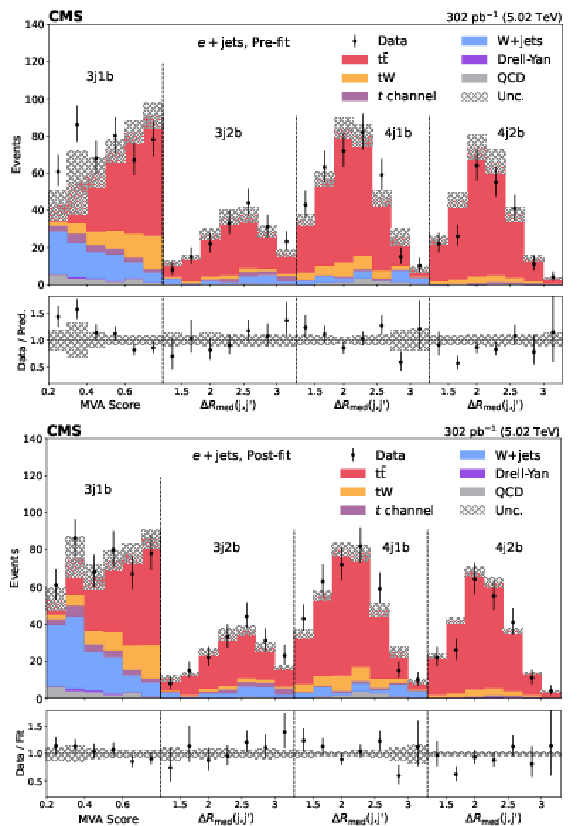
png pdf |
Figure 4:
Distributions for the e+jets final state before (upper plot) and after (lower plot) the maximum likelihood fit: MVA score bins for the 3j1b category and $ \Delta R_\mathrm{med}($\mathrm{j}$,\mathrm{j}') $ bins for the other categories. The vertical error bars represent the statistical uncertainty in the data, and the shaded band the uncertainty of the prediction. All uncertainties considered in the analysis are included in the uncertainty band. The lower panels show the ratio of data to prediction or data to fit, respectively. The first and last bins in each distribution include underflow and overflow events, respectively. |
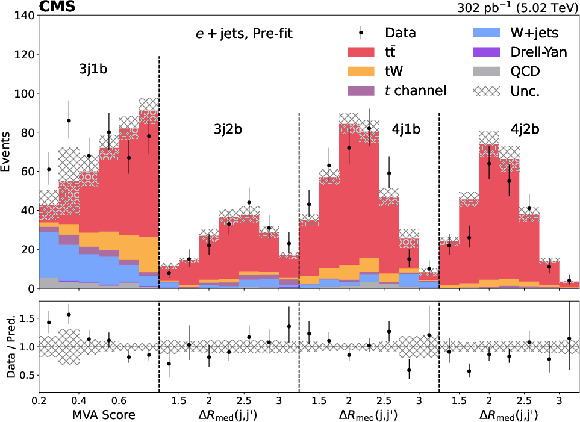
png pdf |
Figure 4-a:
Distributions for the e+jets final state before (upper plot) and after (lower plot) the maximum likelihood fit: MVA score bins for the 3j1b category and $ \Delta R_\mathrm{med}($\mathrm{j}$,\mathrm{j}') $ bins for the other categories. The vertical error bars represent the statistical uncertainty in the data, and the shaded band the uncertainty of the prediction. All uncertainties considered in the analysis are included in the uncertainty band. The lower panels show the ratio of data to prediction or data to fit, respectively. The first and last bins in each distribution include underflow and overflow events, respectively. |

png pdf |
Figure 4-b:
Distributions for the e+jets final state before (upper plot) and after (lower plot) the maximum likelihood fit: MVA score bins for the 3j1b category and $ \Delta R_\mathrm{med}($\mathrm{j}$,\mathrm{j}') $ bins for the other categories. The vertical error bars represent the statistical uncertainty in the data, and the shaded band the uncertainty of the prediction. All uncertainties considered in the analysis are included in the uncertainty band. The lower panels show the ratio of data to prediction or data to fit, respectively. The first and last bins in each distribution include underflow and overflow events, respectively. |

png pdf |
Figure 5:
Distributions for the $ \mu $+jets final state before (upper plot) and after (lower plot) the maximum likelihood fit: MVA score bins for the 3j1b category and $ \Delta R_\mathrm{med}(\mathrm{j},\mathrm{j}') $ bins for the other categories. The vertical error bars represent the statistical uncertainty in the data, and the shaded band the uncertainty of the prediction. All uncertainties considered in the analysis are included in the uncertainty band. The lower panels show the ratio of data to prediction or data to fit, respectively. The first and last bins in each distribution include underflow and overflow events, respectively. |
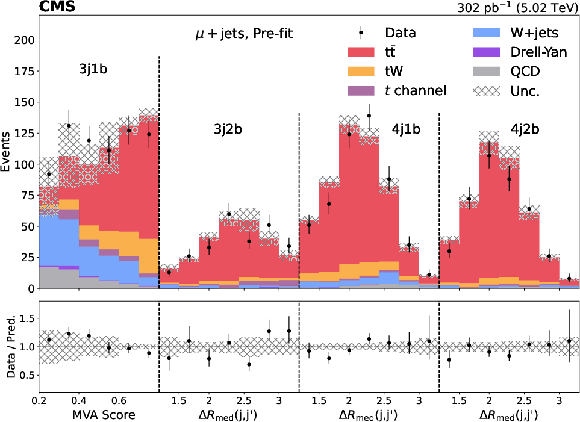
png pdf |
Figure 5-a:
Distributions for the $ \mu $+jets final state before (upper plot) and after (lower plot) the maximum likelihood fit: MVA score bins for the 3j1b category and $ \Delta R_\mathrm{med}(\mathrm{j},\mathrm{j}') $ bins for the other categories. The vertical error bars represent the statistical uncertainty in the data, and the shaded band the uncertainty of the prediction. All uncertainties considered in the analysis are included in the uncertainty band. The lower panels show the ratio of data to prediction or data to fit, respectively. The first and last bins in each distribution include underflow and overflow events, respectively. |

png pdf |
Figure 5-b:
Distributions for the $ \mu $+jets final state before (upper plot) and after (lower plot) the maximum likelihood fit: MVA score bins for the 3j1b category and $ \Delta R_\mathrm{med}(\mathrm{j},\mathrm{j}') $ bins for the other categories. The vertical error bars represent the statistical uncertainty in the data, and the shaded band the uncertainty of the prediction. All uncertainties considered in the analysis are included in the uncertainty band. The lower panels show the ratio of data to prediction or data to fit, respectively. The first and last bins in each distribution include underflow and overflow events, respectively. |

png pdf |
Figure 6:
The largest impacts on the signal strength, $ \Delta\hat{r} $ (right column) and ratios $ (\hat{\theta}-\theta_0)/\Delta\theta $ (middle column) for the nuisance parameters listed in the left column from the maximum likelihood fit used to determine the $ \mathrm{t} \overline{\mathrm{t}} $ cross section. The horizontal bars in the rightmost plot show the ratio of the uncertainties of the fit result to the pre-fit ones, effectively giving the constraint on the nuisance parameter. The JES uncertainties are divided into several sources, where ''JES-Flavour'' comes from the corrections applied to correct the different detector response to gluon and quark jets, and ''JES-RelJER'' accounts for the $ \eta $ dependence uncertainty from jet $ p_{\mathrm{T}} $ resolution. |
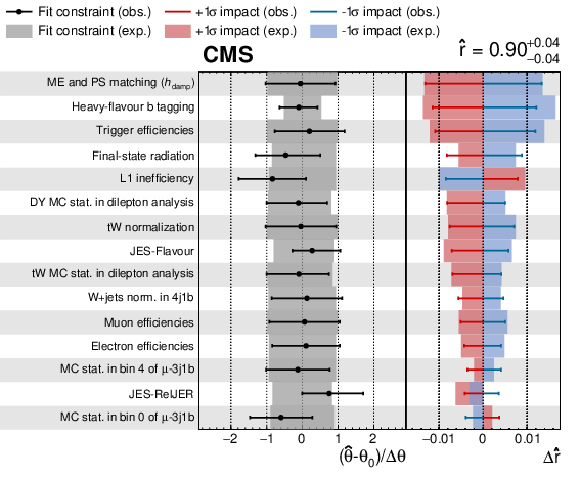
png pdf |
Figure 7:
The largest impacts on the signal strength, $ \Delta\hat{r} $ (right column) and ratios $ (\hat{\theta}-\theta_{0})/\Delta\theta $ (middle column) for the nuisance parameters listed in the left column from the maximum likelihood fit in the combination with the dilepton result, used to determine the $ \mathrm{t} \overline{\mathrm{t}} $ cross section. The horizontal bars in the rightmost plot show the ratio of the uncertainties of the fit result to the pre-fit ones, effectively giving the constraint on the nuisance parameter. The JES uncertainties are divided into several sources, accounting for different effects, where ''JES-Flavour'' comes from the corrections applied to correct the different detector response to gluon and quark jets, and ''JES-RelJER'' accounts for the $ \eta $ dependence uncertainty from jet $ p_{\mathrm{T}} $ resolution. |
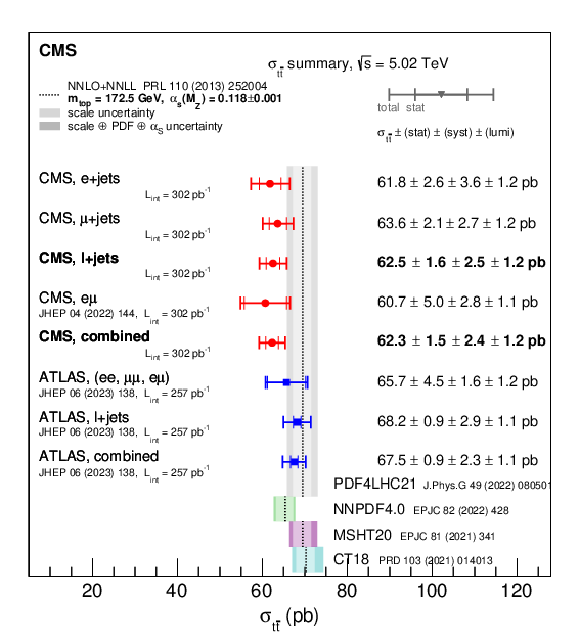
png pdf |
Figure 8:
Summary of the most recent measurements from the ATLAS and CMS Collaborations using data collected at $ \sqrt{s}= $ 5.02 TeV. In the plot also several theoretical predictions are shown: the current prediction [64] (calculated with the PDF4LHC21 set) and other previous predictions using different PDF sets [65,66,67]. |
| Tables | |

png pdf |
Table 1:
Summary of MC samples used to model the signal and background processes. The last column corresponds to the pQCD and EW order of approximation used to normalize the distributions provided by the generators. The predictions for $ \mathrm{t} \overline{\mathrm{t}} $ and $ t $ channel and $ \mathrm{t}\mathrm{W} $ single top quark production are calculated with the PDF4LHC prescription [35]. Approximate NNLO refers to NLO calculation matched with PS resummation. |

png pdf |
Table 2:
Summary of the variables used for the training of the MVA classifier in the 3j1b categories. The variables are ordered according to their discriminating power. |
| Summary |
| A measurement of the top quark pair production cross section in proton-proton collisions at a centre-of-mass energy of 5.02 TeV is performed for events with one electron or one muon and multiple jets using data collected by the CMS experiment in 2017 in conditions of low number of additional interactions per bunch crossing, corresponding to an integrated luminosity of 302 pb$^{-1}$. The dominant background sources in the analysis are W+jets and tW processes. In addition, the contribution from quantum chromodynamics multijet events is estimated from data. The cross section is measured using a maximum likelihood fit to eight event categories defined in terms of the number of jets, b-tagged jets and lepton flavour. The cross section is found to be 62.5 $ \pm $ 1.6 (stat) $ \,^{+2.6}_{-2.5} $ (syst) $ \pm $ 1.2 (lumi) pb. This measurement is combined with the result obtained in the dilepton channel, based on the same data set, resulting in a value of 62.3 $ \pm $ 1.5 (stat) $ \pm $ 2.4 (syst) $ \pm $ 1.2 (lumi) pb. In both cases, the dominant uncertainties are those associated with the integrated luminosity and with the b tagging scale factors for heavy flavours. These values are consistent within two standard deviations with the standard model prediction and of previous measurements from CMS and ATLAS. |
| References | ||||
| 1 | CDF and D0 Collaborations | Combination of measurements of the top-quark pair production cross section from the Tevatron collider | PRD 89 (2014) 072001 | 1309.7570 |
| 2 | CMS Collaboration | Measurement of the inclusive $ \mathrm{t} \overline{\mathrm{t}} $ cross section in $ {\mathrm{p}\mathrm{p}} $ collisions at $ \sqrt{s}= $ 5.02 TeV using final states with at least one charged lepton | JHEP 03 (2018) 115 | CMS-TOP-16-023 1711.03143 |
| 3 | CMS Collaboration | Measurement of the inclusive $ \mathrm{t} \overline{\mathrm{t}} $ production cross section in proton-proton collisions at $ \sqrt{s}= $ 5.02 TeV | JHEP 04 (2022) 144 | CMS-TOP-20-004 2112.09114 |
| 4 | ATLAS Collaboration | Measurement of the $ \mathrm{t} \overline{\mathrm{t}} $ production cross-section in $ {\mathrm{p}\mathrm{p}} $ collisions at $ \sqrt{s}= $ 5.02 TeV with the ATLAS detector | JHEP 06 (2023) 138 | 2207.01354 |
| 5 | ATLAS and CMS Collaborations | Combination of inclusive top-quark pair production cross-section measurements using ATLAS and CMS data at $ \sqrt{s}= $ 7 and 8 TeV | JHEP 07 (2023) 213 | 2205.13830 |
| 6 | ATLAS Collaboration | Measurement of the $ \mathrm{t} \overline{\mathrm{t}} $ production cross-section and lepton differential distributions in $ {\mathrm{e}\mu} $ dilepton events from $ {\mathrm{p}\mathrm{p}} $ collisions at $ \sqrt{s}= $ 13 TeV with the ATLAS detector | EPJC 80 (2020) 528 | 1910.08819 |
| 7 | CMS Collaboration | Measurement of the top quark pair production cross section in proton-proton collisions at $ \sqrt{s}= $ 13 TeV | PRL 116 (2016) 052002 | CMS-TOP-15-003 1510.05302 |
| 8 | CMS Collaboration | Measurement of the $ \mathrm{t} \overline{\mathrm{t}} $ production cross section using events in the $ {\mathrm{e}\mu} $ final state in $ {\mathrm{p}\mathrm{p}} $ collisions at $ \sqrt{s}= $ 13 TeV | EPJC 77 (2017) 172 | CMS-TOP-16-005 1611.04040 |
| 9 | CMS Collaboration | Measurement of differential $ \mathrm{t} \overline{\mathrm{t}} $ production cross sections in the full kinematic range using lepton+jets events from proton-proton collisions at $ \sqrt{s}= $ 13 TeV | PRD 104 (2021) 092013 | CMS-TOP-20-001 2108.02803 |
| 10 | LHCb Collaboration | Measurement of forward top pair production in the dilepton channel in $ {\mathrm{p}\mathrm{p}} $ collisions at $ \sqrt{s}= $ 13 TeV | JHEP 08 (2018) 174 | 1803.05188 |
| 11 | CMS Collaboration | First measurement of the top quark pair production cross section in proton-proton collisions at $ \sqrt{s}= $ 13.6 TeV | JHEP 08 (2023) 204 | CMS-TOP-22-012 2303.10680 |
| 12 | ATLAS Collaboration | Measurement of the $ \mathrm{t} \overline{\mathrm{t}} $ cross section and its ratio to the Z production cross section using $ {\mathrm{p}\mathrm{p}} $ collisions at $ \sqrt{s}= $ 13.6 TeV with the ATLAS detector | PLB 848 (2024) 138376 | 2308.09529 |
| 13 | CMS Collaboration | Observation of top quark production in proton-nucleus collisions | PRL 119 (2017) 242001 | CMS-HIN-17-002 1709.07411 |
| 14 | CMS Collaboration | Evidence for top quark production in nucleus-nucleus collisions | PRL 125 (2020) 222001 | CMS-HIN-19-001 2006.11110 |
| 15 | CMS Collaboration | Measurement of double-differential cross sections for top quark pair production in $ {\mathrm{p}\mathrm{p}} $ collisions at $ \sqrt{s}= $ 8 TeV and impact on parton distribution functions | EPJC 77 (2017) 459 | CMS-TOP-14-013 1703.01630 |
| 16 | S. Catani, M. L. Mangano, P. Nason, and L. Trentadue | The top cross section in hadronic collisions | PLB 378 (1996) 329 | hep-ph/9602208 |
| 17 | CMS Collaboration | HEPData record for this analysis | link | |
| 18 | CMS Collaboration | The CMS experiment at the CERN LHC | JINST 3 (2008) S08004 | |
| 19 | CMS Collaboration | Development of the CMS detector for the CERN LHC \mboxRun 3 | JINST 19 (2024) P05064 | CMS-PRF-21-001 2309.05466 |
| 20 | CMS Collaboration | The CMS trigger system | JINST 12 (2017) P01020 | CMS-TRG-12-001 1609.02366 |
| 21 | CMS Collaboration | Performance of the CMS Level-1 trigger in proton-proton collisions at $ \sqrt{s}= $ 13 TeV | JINST 15 (2020) P10017 | CMS-TRG-17-001 2006.10165 |
| 22 | GEANT4 Collaboration | GEANT 4---a simulation toolkit | NIM A 506 (2003) 250 | |
| 23 | S. Frixione, P. Nason, and C. Oleari | Matching NLO QCD computations with parton shower simulations: the POWHEG method | JHEP 11 (2007) 070 | 0709.2092 |
| 24 | S. Alioli, P. Nason, C. Oleari, and E. Re | A general framework for implementing NLO calculations in shower Monte Carlo programs: the POWHEG \textscbox | JHEP 06 (2010) 043 | 1002.2581 |
| 25 | S. Frixione, G. Ridolfi, and P. Nason | A positive-weight next-to-leading-order Monte Carlo for heavy flavour hadroproduction | JHEP 09 (2007) 126 | 0707.3088 |
| 26 | P. Nason | A new method for combining NLO QCD with shower Monte Carlo algorithms | JHEP 11 (2004) 040 | hep-ph/0409146 |
| 27 | NNPDF Collaboration | Parton distributions from high-precision collider data | EPJC 77 (2017) 663 | 1706.00428 |
| 28 | J. Alwall et al. | The automated computation of tree-level and next-to-leading order differential cross sections, and their matching to parton shower simulations | JHEP 07 (2014) 079 | 1405.0301 |
| 29 | R. Frederix and S. Frixione | Merging meets matching in MC@NLO | JHEP 12 (2012) 061 | 1209.6215 |
| 30 | T. Sjöstrand et al. | An introduction to PYTHIA8.2 | Comput. Phys. Commun. 191 (2015) 159 | 1410.3012 |
| 31 | CMS Collaboration | Extraction and validation of a new set of CMS PYTHIA8 tunes from underlying-event measurements | EPJC 80 (2020) 4 | CMS-GEN-17-001 1903.12179 |
| 32 | M. Czakon and A. Mitov | \textsctop++: a program for the calculation of the top-pair cross-section at hadron colliders | Comput. Phys. Commun. 185 (2014) 2930 | 1112.5675 |
| 33 | M. Czakon, P. Fiedler, and A. Mitov | Total top-quark pair-production cross section at hadron colliders through $ \mathcal{O}({\alpha_\mathrm{S}}^4) $ | PRL 110 (2013) 252004 | 1303.6254 |
| 34 | Particle Data Group , R. L. Workman et al. | Review of particle physics | Prog. Theor. Exp. Phys. 2022 (2022) 083C01 | |
| 35 | J. Butterworth et al. | PDF4LHC recommendations for LHC \mboxRun 2 | JPG 43 (2016) 023001 | 1510.03865 |
| 36 | A. D. Martin, W. J. Stirling, R. S. Thorne, and G. Watt | Parton distributions for the LHC | EPJC 63 (2009) 189 | 0901.0002 |
| 37 | A. D. Martin, W. J. Stirling, R. S. Thorne, and G. Watt | Uncertainties on $ \alpha_\mathrm{S} $ in global PDF analyses and implications for predicted hadronic cross sections | EPJC 64 (2009) 653 | 0905.3531 |
| 38 | H.-L. Lai et al. | New parton distributions for collider physics | PRD 82 (2010) 074024 | 1007.2241 |
| 39 | J. Gao et al. | CT10 next-to-next-to-leading order global analysis of QCD | PRD 89 (2014) 033009 | 1302.6246 |
| 40 | NNPDF Collaboration | Parton distributions with LHC data | NPB 867 (2013) 244 | 1207.1303 |
| 41 | J. Campbell, T. Neumann, and Z. Sullivan | Single-top-quark production in the $ t $-channel at NNLO | JHEP 02 (2021) 040 | 2012.01574 |
| 42 | N. Kidonakis and N. Yamanaka | Higher-order corrections for $ {\mathrm{t}\mathrm{W}} $ production at high-energy hadron colliders | JHEP 05 (2021) 278 | 2102.11300 |
| 43 | K. Melnikov and F. Petriello | Electroweak gauge boson production at hadron colliders through $ \mathcal{O}({\alpha_\mathrm{S}^2}) $ | PRD 74 (2006) 114017 | hep-ph/0609070 |
| 44 | CMS Collaboration | Particle-flow reconstruction and global event description with the CMS detector | JINST 12 (2017) P10003 | CMS-PRF-14-001 1706.04965 |
| 45 | M. Cacciari, G. P. Salam, and G. Soyez | The anti-$ k_{\mathrm{T}} $ jet clustering algorithm | JHEP 04 (2008) 063 | 0802.1189 |
| 46 | M. Cacciari, G. P. Salam, and G. Soyez | FASTJET user manual | EPJC 72 (2012) 1896 | 1111.6097 |
| 47 | CMS Collaboration | Jet energy scale and resolution in the CMS experiment in $ {\mathrm{p}\mathrm{p}} $ collisions at 8 TeV | JINST 12 (2017) P02014 | CMS-JME-13-004 1607.03663 |
| 48 | CMS Collaboration | Jet algorithms performance in 13 TeV data | CMS Physics Analysis Summary, 2017 CMS-PAS-JME-16-003 |
CMS-PAS-JME-16-003 |
| 49 | CMS Collaboration | Identification of heavy-flavour jets with the CMS detector in $ {\mathrm{p}\mathrm{p}} $ collisions at 13 TeV | JINST 13 (2018) P05011 | CMS-BTV-16-002 1712.07158 |
| 50 | CMS Collaboration | Electron and photon reconstruction and identification with the CMS experiment at the CERN LHC | JINST 16 (2021) P05014 | CMS-EGM-17-001 2012.06888 |
| 51 | CMS Collaboration | Performance of the CMS muon detector and muon reconstruction with proton-proton collisions at $ \sqrt{s}= $ 13 TeV | JINST 13 (2018) P06015 | CMS-MUO-16-001 1804.04528 |
| 52 | CMS Collaboration | Technical proposal for the Phase-II upgrade of the Compact Muon Solenoid | CMS Technical Proposal CERN-LHCC-2015-010, CMS-TDR-15-02, 2015 link |
|
| 53 | CMS Collaboration | Muon identification using multivariate techniques in the CMS experiment in proton-proton collisions at $ \sqrt{s}= $ 13 TeV | JINST 19 (2024) P02031 | CMS-MUO-22-001 2310.03844 |
| 54 | CMS Collaboration | Performance of missing transverse momentum reconstruction in proton-proton collisions at $ \sqrt{s}= $ 13 TeV using the CMS detector | JINST 14 (2019) P07004 | CMS-JME-17-001 1903.06078 |
| 55 | A. Prinzie and D. Van den Poel | Random multiclass classification: Generalizing random forests to random MNL and random NB | in Proc. 18th International Conference on Database and Expert Systems Applications (DEXA ): Regensburg, Germany, 2007 link |
|
| 56 | L. Breiman | Random forests | Machine Learning 45 (2001) 5 | |
| 57 | C. J. Clopper and E. S. Pearson | The use of confidence or fiducial limits illustrated in the case of the binomial | Biometrika 26 (1934) 404 | |
| 58 | CMS Collaboration | Measurement of the production cross section of a W boson in association with two b jets in $ {\mathrm{p}\mathrm{p}} $ collisions at $ \sqrt{s}= $ 8 TeV | EPJC 77 (2017) 92 | CMS-SMP-14-020 1608.07561 |
| 59 | CMS Collaboration | Luminosity measurement in proton-proton collisions at 5.02 TeV in 2017 at CMS | CMS Physics Analysis Summary, 2021 CMS-PAS-LUM-19-001 |
CMS-PAS-LUM-19-001 |
| 60 | CMS Collaboration | Precision luminosity measurement in proton-proton collisions at $ \sqrt{s}= $ 13 TeV in 2015 and 2016 at CMS | EPJC 81 (2021) 800 | CMS-LUM-17-003 2104.01927 |
| 61 | J. S. Conway | Incorporating nuisance parameters in likelihoods for multisource spectra | in Proc. 2011 Workshop on Statistical Issues Related to Discovery Claims in Search Experiments and Unfolding (PHYSTAT ): Geneva, Switzerland, 2011 link |
1103.0354 |
| 62 | CMS Collaboration | The CMS statistical analysis and combination tool: \textsccombine | Accepted by Comput. Softw. Big Sci, 2024 | CMS-CAT-23-001 2404.06614 |
| 63 | ATLAS and CMS Collaborations | Combination of measurements of the top quark mass from data collected by the ATLAS and CMS experiments at $ \sqrt{s}= $ 7 and 8 TeV | PRL 132 (2024) 261902 | 2402.08713 |
| 64 | PDF4LHC Working Group, R. D. Ball et al. | The PDF4LHC21 combination of global PDF fits for the LHC Run 3 | JPG 49 (2022) 080501 | 2203.05506 |
| 65 | NNPDF Collaboration | The path to proton structure at 1\% accuracy | EPJC 82 (2022) 428 | 2109.02653 |
| 66 | S. Bailey et al. | Parton distributions from LHC, HERA, Tevatron and fixed target data: MSHT20 PDFs | EPJC 81 (2021) 341 | 2012.04684 |
| 67 | T.-J. Hou et al. | New CTEQ global analysis of quantum chromodynamics with high-precision data from the LHC | PRD 103 (2021) 014013 | 1912.10053 |

|
Compact Muon Solenoid LHC, CERN |

|

|

|

|

|

|